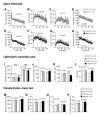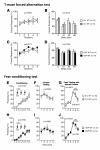Comprehensive behavioral analysis of ENU-induced Disc1-Q31L and -L100P mutant mice
- PMID: 22348257
- PMCID: PMC3392730
- DOI: 10.1186/1756-0500-5-108
Comprehensive behavioral analysis of ENU-induced Disc1-Q31L and -L100P mutant mice
Abstract
Background: Disrupted-in-Schizophrenia 1 (DISC1) is considered to be a candidate susceptibility gene for psychiatric disorders, including schizophrenia, bipolar disorder, and major depression. A recent study reported that N-ethyl-N-nitrosourea (ENU)-induced mutations in exon 2 of the mouse Disc1 gene, which resulted in the amino acid exchange of Q31L and L100P, caused an increase in depression-like behavior in 31 L mutant mice and schizophrenia-like behavior in 100P mutant mice; thus, these are potential animal models of psychiatric disorders. However, remaining heterozygous mutations that possibly occur in flanking genes other than Disc1 itself might induce behavioral abnormalities in the mutant mice. Here, to confirm the effects of Disc1-Q31L and Disc1-L100P mutations on behavioral phenotypes and to investigate the behaviors of the mutant mice in more detail, the mutant lines were backcrossed to C57BL/6JJcl through an additional two generations and the behaviors were analyzed using a comprehensive behavioral test battery.
Results: Contrary to expectations, 31 L mutant mice showed no significant behavioral differences when compared with wild-type control mice in any of the behavioral tests, including the Porsolt forced swim and tail suspension tests, commonly used tests for depression-like behavior. Also, 100P mutant mice exhibited no differences in almost all of the behavioral tests, including the prepulse inhibition test for measuring sensorimotor gating, which is known to be impaired in schizophrenia patients; however, 100P mutant mice showed higher locomotor activity compared with wild-type control mice in the light/dark transition test.
Conclusions: Although these results are partially consistent with the previous study in that there was hyperactivity in 100P mutant mice, the vast majority of the results are inconsistent with those of the previous study; this discrepancy may be explained by differences in the genetic background of the mice, the laboratory environment, experimental protocols, and more. Further behavioral studies under various experimental conditions are necessary to determine whether these Disc1 mutant mouse lines are suitable animal models of schizophrenia and major depression.
Figures






Similar articles
-
Effects of background mutations and single nucleotide polymorphisms (SNPs) on the Disc1 L100P behavioral phenotype associated with schizophrenia in mice.Behav Brain Funct. 2014 Dec 8;10:45. doi: 10.1186/1744-9081-10-45. Behav Brain Funct. 2014. PMID: 25487992 Free PMC article.
-
Maternal immune activation during gestation interacts with Disc1 point mutation to exacerbate schizophrenia-related behaviors in mice.J Neurosci. 2013 May 1;33(18):7654-66. doi: 10.1523/JNEUROSCI.0091-13.2013. J Neurosci. 2013. PMID: 23637159 Free PMC article.
-
ENU-mutagenesis mice with a non-synonymous mutation in Grin1 exhibit abnormal anxiety-like behaviors, impaired fear memory, and decreased acoustic startle response.BMC Res Notes. 2013 May 21;6:203. doi: 10.1186/1756-0500-6-203. BMC Res Notes. 2013. PMID: 23688147 Free PMC article.
-
Investigating gene-to-behavior pathways in psychiatric disorders: the use of a comprehensive behavioral test battery on genetically engineered mice.Ann N Y Acad Sci. 2006 Nov;1086:144-59. doi: 10.1196/annals.1377.008. Ann N Y Acad Sci. 2006. PMID: 17185513 Review.
-
Modeling the positive symptoms of schizophrenia in genetically modified mice: pharmacology and methodology aspects.Schizophr Bull. 2010 Mar;36(2):246-70. doi: 10.1093/schbul/sbp132. Epub 2009 Nov 9. Schizophr Bull. 2010. PMID: 19900963 Free PMC article. Review.
Cited by
-
Epistatic and Independent Effects on Schizophrenia-Related Phenotypes Following Co-disruption of the Risk Factors Neuregulin-1 × DISC1.Schizophr Bull. 2017 Jan;43(1):214-225. doi: 10.1093/schbul/sbw120. Epub 2016 Sep 9. Schizophr Bull. 2017. PMID: 27613806 Free PMC article.
-
Disrupted in schizophrenia 1 (DISC1) L100P mutants have impaired activity-dependent plasticity in vivo and in vitro.Transl Psychiatry. 2016 Jan 12;6(1):e712. doi: 10.1038/tp.2015.206. Transl Psychiatry. 2016. PMID: 26756905 Free PMC article.
-
Utility and validity of DISC1 mouse models in biological psychiatry.Neuroscience. 2016 May 3;321:99-107. doi: 10.1016/j.neuroscience.2015.12.061. Epub 2016 Jan 6. Neuroscience. 2016. PMID: 26768401 Free PMC article. Review.
-
Absence of BRINP1 in mice causes increase of hippocampal neurogenesis and behavioral alterations relevant to human psychiatric disorders.Mol Brain. 2014 Feb 14;7:12. doi: 10.1186/1756-6606-7-12. Mol Brain. 2014. PMID: 24528488 Free PMC article.
-
Effects of background mutations and single nucleotide polymorphisms (SNPs) on the Disc1 L100P behavioral phenotype associated with schizophrenia in mice.Behav Brain Funct. 2014 Dec 8;10:45. doi: 10.1186/1744-9081-10-45. Behav Brain Funct. 2014. PMID: 25487992 Free PMC article.
References
-
- Owen MJ, Williams NM, O'Donovan MC. The molecular genetics of schizophrenia: new findings promise new insights. Mol Psychiatry. 2004;9:14–27. - PubMed
-
- Stefansson H, Petursson H, Sigurdsson E, Steinthorsdottir V, Bjornsdottir S, Sigmundsson T, Ghosh S, Brynjolfsson J, Gunnarsdottir S, Ivarsson O, Chou TT, Hjaltason O, Birgisdottir B, Jonsson H, Gudnadottir VG, Gudmundsdottir E, Bjornsson A, Ingvarsson B, Ingason A, Sigfusson S, Hardardottir H, Harvey RP, Lai D, Zhou M, Brunner D, Mutel V, Gonzalo A, Lemke G, Sainz J, Johannesson G, Andresson T, Gudbjartsson D, Manolescu A, Frigge ML, Gurney ME, Kong A, Gulcher JR, Stefansson K. Neuregulin 1 and susceptibility to schizophrenia. Am J Hum Genet. 2002;71:877–892. doi: 10.1086/342734. - DOI - PMC - PubMed
-
- Ekelund J, Lichtermann D, Hovatta I, Ellonen P, Suvisaari J, Terwilliger JD, Juvonen H, Varilo T, Arajärvi R, Kokko-Sahin ML, Lönnqvist J, Peltonen L. Genome-wide scan for schizophrenia in the Finnish population: evidence for a locus on chromosome 7q22. Hum Mol Genet. 2000;9:1049–1057. doi: 10.1093/hmg/9.7.1049. - DOI - PubMed
Publication types
MeSH terms
Substances
LinkOut - more resources
Full Text Sources
Molecular Biology Databases

